+heroes Of Nusantara: Multatuli
+heroes of nusantara: multatuli
YES, I, Multatuli, “who have suffered much,”—I take the pen. I do not make any excuses for the form of my book,—that form was thought proper to obtain my object…. I will be read! Yes, I will be read. I will be read by statesmen who are obliged to pay attention to the signs of the times; by men of letters, who must also look into the book of which so many bad things are said; by merchants, who have an interest in the coffee auctions; by lady’s-maids, who read me for a few farthings; by governors-general in retirement; by ministers who have something to do; by the lackeys of these Excellencies; by mutes, who, more majorum, will say that I attack God Almighty, when I attack only the god which they made according to their own image; by the members of the representative chambers, who must know what happens in the extensive possessions over the sea which belong to Holland….
Ay, I shall be read!

Eduard Douwes Dekker was born in Amsterdam, March 2nd 1820. His father was a ship’s captain and intended for his son to have a career in trade. This humdrum prospect disgusted Douwes Dekker and in 1838 he obtained a post as a civil servant on the island of Java. During the period between 1848 and 1851 Douwes Dekker eventually rose to serve as assistant resident in various regencies in the Indonesian archipelago including Natal, North Sumatra, Manado in Sulawesi and Ambon in the Moluccas. In 1857 he was transferred to Lebak, in the Bantam residency of Java (now Banten province). By this time, however, all the secrets of Dutch administration were known to him, and he had begun to openly protest about the abuses of the colonial system. Consequently, he was threatened with dismissal from his office for his openness of speech. Douwes Dekker resigned his appointment and returned to the Netherlands.
He was determined to expose in detail the scandals he had witnessed, and he began to do so in newspaper articles and pamphlets. Little notice, however, was taken of his protestations until, in 1860, he published his novel Max Havelaar under the pseudonym of Multatuli. Douwes Dekker’s new pseudonym, which is derived from Latin, means, “I have suffered much”, or, more literally “I have borne much” referring to himself, as well as, it is thought, to the victims of the injustices he saw. An attempt was made to suppress the inflammatory book, but in vain; it was read all over Europe. Apologists for colonialism accused Douwes Dekker’s horrific depictions of being exaggerated.

[ his statue in amsterdam ]
Although it was translated into English in 1868, the text wasn’t available in the author’s home country until over a century later in 1972. Collectively, Multatuli’s Max Havelaar has been translated into 34 different languages worldwide since its initial publication. Credited as the stirring initiation of the nationalist movement responsible for the termination of Dutch colonization of Indonesia following World War II, Max Havelaar’s legacy is not confined to literary accomplishment, but can be considered a work of great political success and inspired social liberation. Max Havelaar’s influence on the national movement ultimately culminated in the passionate command to end decolonization worldwide. The story of Max Havelaar illuminates the inhumane and political injustices brutally imposed upon the native peoples of the region.
Sigmund Freud listed Multatuli as one of his favorite writers. Multatuli’s brother, Jan Douwes Dekker, was the grandfather of Ernest Douwes Dekker (also known as Danudirja Setiabudi, a National Hero of Indonesia). There is a museum for him in Amsterdam. Multatuli is also known as the person who coined the term emerald of equator, a poetic nickname of Indonesia.

This book is an introduction…. I shall increase in strength and sharpness of weapons, according as it may be necessary. Heaven grant that it may not be necessary!… No, it will not be necessary! For it is to thee I dedicate my book: WILLIAM THE THIRD, King, Grand Duke, Prince,… more than Prince, Grand Duke, and King,… EMPEROR of the magnificent empire of INSULIND, which winds about the equator like a garland of emeralds!… I ask THEE if it be thine IMPERIAL will that the Havelaars should be bespattered with the mud of Slymerings and Drystubbles; and that thy more than thirty millions of SUBJECTS far away should be ill treated and should suffer extortion in THY name!
source: wikipedia; culture trip
quotes from bartleby, excerpt of max havelaar
further reading: paper on multatuli
More Posts from Philosophical-amoeba and Others
A Random PSA On The Gei of Geisha - Part 1
The questions surrounding what arts that maiko and geiko practice comes up regularly, and instead of just posting them onto one of the tabs I’d rather lay it out in a post here first. The “Gei” (芸) in Geisha(芸者)/Geiko(芸妓)/Geigi(芸妓) means “Art” and there are many branches and types of art that one can master. For this part we’ll be looking at the direct performing arts that everyone knows the geisha are renowned for: music and dance. Dance - Mai (舞) All traditional Japanese dance styles have their roots in Shinto ceremonies that date back at least two millennia. There are two main styles to traditional dance practiced today: -Noh (能): Originally arrived in Japan from China in the 8th century and developed into the style we know today in the 13th century by Kan’ami (assisted by his son Zeami). Derived from the classical court style dances, it features small, precise movements to tell a story. It can be seen as “boring” or “obscure” if you’re not sure what to look for as you need to understand the movements to appreciate them to the fullest. This isn’t to say that it isn’t beautiful to behold without prior knowledge as it is quite enchanting! Gion Kobu’s Inoue school is part of the Noh tradition. -Kabuki (歌舞伎): Derived directly from Shinto ceremonies, it was created in 1603 by Izumo No Okuni, a shrine priestess who created her own style of dance and performed it on the dry riverbed of the Kamo River. She became so famous that she was invited to perform in front of the emperor! After seeing how popular the style of dance had become rival dance groups sprung up around her and established the kabuki that we know today. The style is known for its dramatic and often “wild” movements that are meant to be appreciated by the common people. Pontocho’s Onoe, Miyagawa Cho’s Wakayagi, Kamishichiken’s Hanayagi, and Gion Higashi’s Fujima schools are part of the Kabuki tradition. Music - Raku (楽) What would dance be without music? Music, like dance, can be broken down into two types: voice/song and instruments. Singing - Uta (歌): Maiko and geiko learn traditional ballads that are performed alongside dance. There are two types: Kouta (小唄) which means “short songs/ballads” and Nagauta (長唄) which means “long songs/ballad.” They are learned by listening to an instructor and then repeating and/or transcribing the words and melody together. There’s no “set” way of reading or learning a song like there is for Western music, so it takes a large amount of practice to perform any uta properly (although there are a few methods that do exist). Instruments - Gakki (楽器) There are many instruments practiced in the karyukai, but I’ll only go over the most common ones that are seen and heard on a regular basis. -Shamisen (三味線): A three stringed instrument that is played with a plectrum. It is the most common instrument in the karyukai as it developed as an instrument that the common people used. Most uta were created to be played with a shamisen. It resembles a simplified guitar and is played in a similar fashion. -Tsuzumi (鼓): The all encompassing word for drums, but specifically dual sided drums that are roped together. There are three main types learned by maiko and geiko: -Kotsuzumi (小鼓): Literally “Small Drum,” or sometimes known as the “regular” tsuzumi, it is held onto one’s shoulder and played by striking the drum with the free hand. -Ōtsuzumi (大鼓): Literally “Large Drum,” it is a larger size of the tsuzumi and features one end that is larger than the other. It produces a much deeper sound when struck. -Kakko (羯鼓): A wide headed tsuzumi that is played with the tsuzumi sitting on the floor and the musician striking it with rods known as bachi (桴). It is the closest equivalent to Western style drums. -Fue (笛): The all encompassing word for flute, which in traditional Japanese style is usually made from bamboo. There are two types of fue that include: -Shakuhachi (尺八): The most commonly seen and heard flute that accompanies traditional Japanese music. It features 5 holes (4 on top and 1 underneath). Its sound is often described as “haunting” as it gently pierces through silence to deliver melodies full of both happiness and sadness. -Shinobue (篠笛)/Yokobue (横笛): Flutes that are much closer to Western ones, but are still made from wood. It features 7 holes that allows it to play more notes than the shakuhachi. This type is often played with the end resting on the musician’s shoulder. -Koto (事): A 13 stringed instrument that’s considered a type of lute although it plays closer to that of a harp. Due to its size it lays flat on the floor and the musician plucks the strings individually to produce sound. Those who are new to the koto often wear metal guards on their fingers to keep the strings from slicing into their skin until their hands have developed enough to withstand the pressure. -Kokyū (胡弓): Taught exclusively in Miyagawa Cho as it was once considered an instrument of the oiran, a kakyu is a smaller version of the shamisen that’s played upright with a bow instead of a plectrum.
In general I am a casual observer and usually do not make comments, especially since I am here to learn and have no background in linguistics. But in this case I feel strongly compelled to put my 2 cents' worth of thoughts in.
Although I cannot say that I am anything like fluent, I do have a reasonable amount of Mandarin Chinese and Japanese, and I have to say the first thing I thought when I saw this article was "ah". Because although I can see how katakana is derived from Chinese, using the rather restricted stroke combinations that is the basis of all Chinese characters, the same cannot be said for hiragana, because at the very least, squiggles do not exist in Chinese, at least by the time it was exported to Japan. What you might think are squiggles in Chinese are in fact just our possibly lazy, or perhaps more elegant way of writing, the way cursive would look compared to printed letters. Hirangana bears only a superficial resemblance to Chinese and always feels like it must have another source of inspiration.
Also keep in mind that Chinese was basically an imported language into Japan, and an attempt to shoehorn Japanese sounds into Chinese characters (which I think I can safely say did not sound the same) must have been unwieldy at best. In fact, today, Japanese pronouciations of kanji differ so much from the Chinese, and often their usage too, that I would use my knowledge of the characters only as a rough starting point as to what they might mean in Japanese.
Also, I looked up Kūkai, and, to cut a long story short, he was a Japanese Buddhist monk who went to China to study the sutras, and, to quote from the Wikipedia page directly:
Kūkai arrived back in Japan in 806 as the eighth Patriarch of Esoteric Buddhism, having learnt Sanskrit and its Siddhaṃ script, studied Indian Buddhism, as well as having studied the arts of Chinese calligraphy and poetry, all with recognized masters. He also arrived with a large number of texts, many of which were new to Japan and were esoteric in character, as well as several texts on the Sanskrit language and the Siddhaṃ script.
And a quick look at the Siddham script shows that it has its roots in the Aramaic alphabet.
This is the man to whom the invention of the kana system is attributed to, and if that is the case, I see a possible connection that is as not as far-fetched as it seems.
The History of Hiragana
In Japanese language, we have three types of letters, Kanji, Hiragana, Katakana.
Hiragana’s root is from old Ivrit and Palmyra letters.

The first column: Phoenician alphabet The second column: Ostracon The third column: Old Aramaic The forth column: Imperial Aramaic The fifth column: Dead Sea scrolls The sixth column: Palmyrene script The seventh column: Palmyra

The first column: Hiragana The second column: Consonants The third column: Vowels The forth column: combined with the consonant and the vowel The fifth column: Sousho-tai (a hand writing style) The sixth column: Kanji

Black Holes are not so Black (Part 3) - Gravitational Waves
The existence of Gravitational Waves have been confirmed. But you probably have heard that. In this post, we will break down this profound discovery into comprehend-able chunks.
This is going to be a amazing journey. Ready ?
Redefining Gravity
When we usually talk of Gravitation we are bound to think like Newton, where objects are assumed to exerting a force upon each other.
Like imaginary arrows of force in space. But this picture, although good for high school crumbled, with the advent of Einstein’s theory of Relativity.

What is the Space-Time Fabric?
Think of space-time fabric as an actual cloth of fabric. ( An analogy )
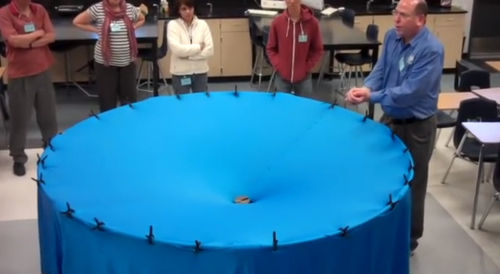
When you place an object on the fabric, the cloth curves. This is exactly what happens in the solar system as well.

The sun with such a huge mass bends the space-time fabric. And the earth and all the planets are kept in orbit by following this curvature that has been made by the sun.
Attributing to the various masses of objects, the way they bend this fabric also varies.
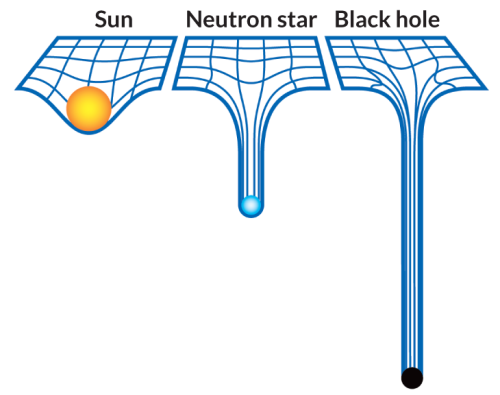
What are Gravitational Waves?
If you drop an object in a medium such as water, they produce ripples that propagate as waves through the medium.

Similarly, Gravitational waves are ripples in space-time fabric produced when you drag heavy objects through space time.
And the nature of these waves is that they don’t require a medium to propagate.
How do you make one?
Everything with mass/energy can create these waves.
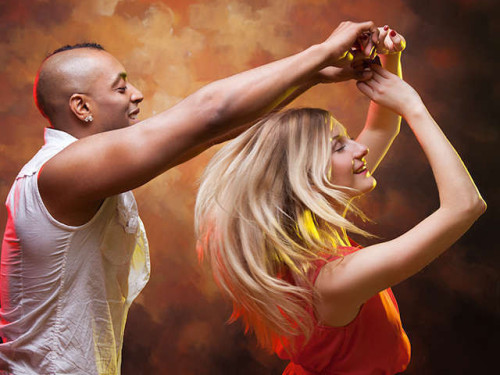
Source
Two persons dancing around each other in space too can create gravitational waves. But the waves would be extremely faint.
You need something big and massive accelerating through space-time in order to even detect them.

And orbiting binary stars/black holes are valuable in this retrospect.
How can you detect them?
Let’s turn to the problem to detecting them assuming you do find binary stars/black-holes in the wondrous space to suite your needs.
Well, for starters you cannot use rocks/ rulers to measure them because as the space expands and contracts, so do the rocks. ( the distances will remain same in both the cases )

Here’s where the high school fact that the speed of Light is a constant no matter what plays an important and pivotal role.
If the space expands, the time taken for light to reach from A to B would be longer. And if it contracts, the time taken for it to reach from A to B would be smaller.

PC: PHDComics
By allowing the light waves from the contraction and expansion to interfere with each other, such as done in any interferometry experiment we can detect the expansion or contraction. Voila!
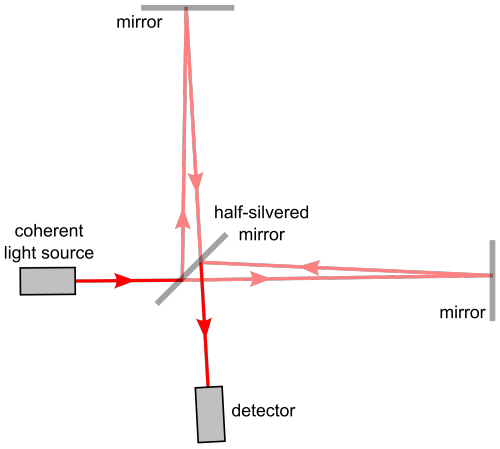
And this is exactly what they did! ( on a macroscopic level ) at LIGO (Laser Interferometer Gravitational-Wave Observatory)
14 September 2015

Two Black Holes with masses of 29 and 36 solar masses merged together some 1.3 Billion light years away.
Two Black Holes colliding is the header animation of the ‘Black Holes are not so Black Series’, in case if you haven’t noticed.

The merger of these two black holes results in the emission of energy equivalent to 3 solar masses as Gravitational Waves.
This signal was seen by both LIGO detectors, in Livingston and Hanford, with a time difference of 7 milliseconds.
And with the measurement of this time difference, physicists have pronounced the existence of Gravitational Waves.

Source
All this is most certainly easily said than done and requires meticulous and extensive research, not to mention highly sensitive instruments.
Had they not have measured this time difference, we might have had to wait for the merger for more massive black holes to collide and maybe even build more sensitive instruments to detect these waves.
And Einstein predicted this a 100 years back!

Mind Blown!
Note: Hope you are able to understand and appreciate the profundity of the discovery done by mankind.
** All animations used here are merely for Educational purposes. If you have any issues, please write to us at : 153armstrong@gmail.com
12 Amazing Facts About Elephants
In honor of World Elephant Day, we present you with 12 little known facts about one of our favorite creatures…in GIFs, of course.
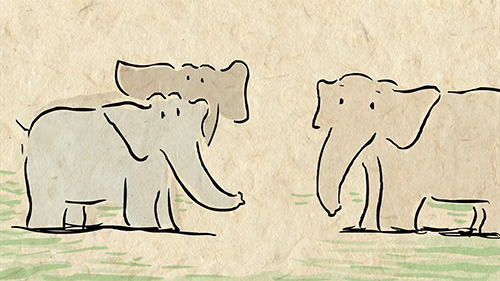
1. Elephants know every member of their herd and are able to recognize up to 30 companions by sight or smell.
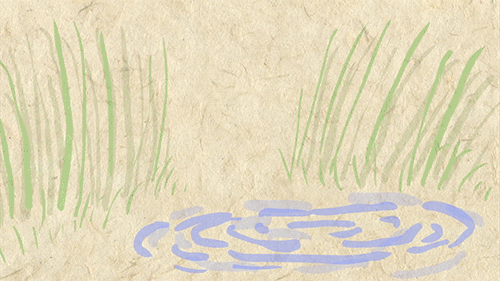
2. They can remember and distinguish particular cues that signal danger and can recall locations long after their last visit.
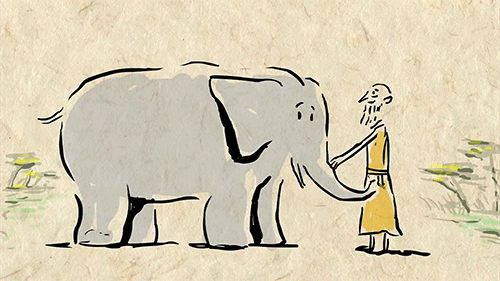
3. An elephant’s memory is not limited to its herd, nor is it limited to its species. In one instance, two circus elephants that performed together rejoiced when crossing paths 23 years later. Elephants have also recognized humans that they once bonded with after decades apart. 4.
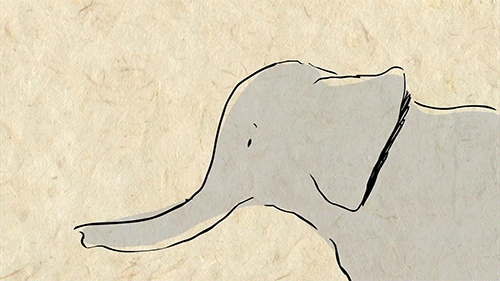
4. The elephant boasts the largest brain of any land mammal as well as an impressive encephalization quotient (the size of the animal’s brain relative to its body size). The elephant’s EQ is nearly as high as a chimpanzee’s.
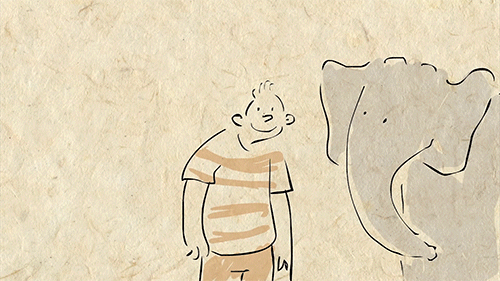
5. The elephant brain is remarkably similar to the human brain, with as many neurons and synapses, as well as a highly developed hippocampus and cerebral cortex.
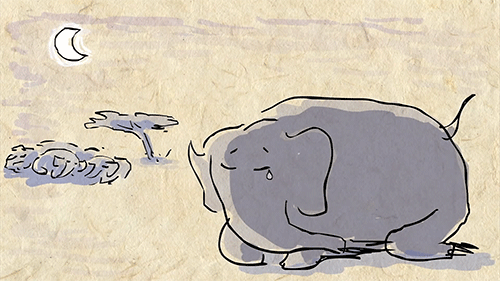
6. Elephants are one of the few non-human animals to suffer from post-traumatic stress disorder.

7. Elephants are creative problem solvers.
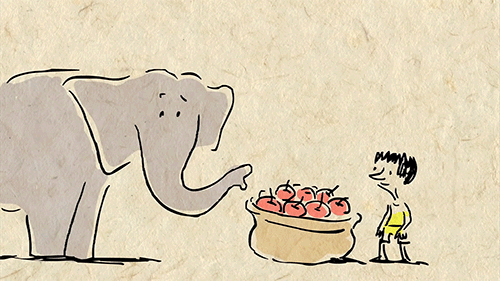
8. Don’t try to outsmart an elephant! They have an understanding of basic arithmetic and can even keep track of relative quantities.
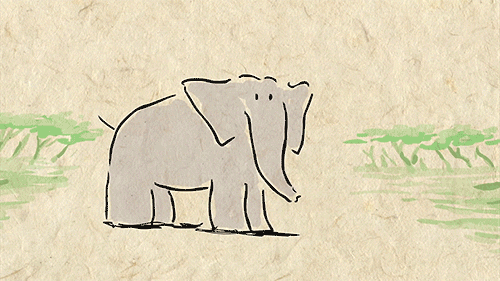
9. Elephants communicate using everything from body signals to infrared rumbles that can be heard from kilometers away. Their understanding of syntax suggests that they have their own language and grammar.
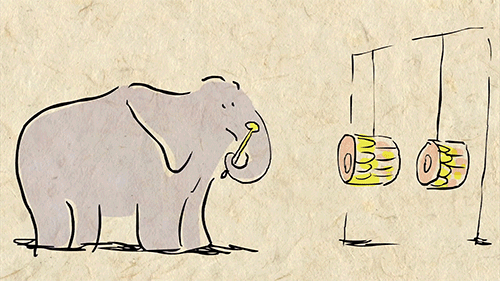
10. Elephants can recognize 12 distinct tones of music and recreate melodies.

11. Elephants are the only non-human animals to mourn their dead, performing burial rituals and returning to visit graves.
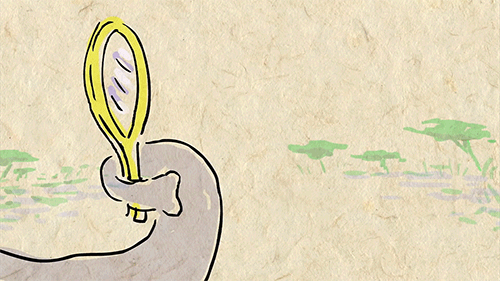
12. Elephants are one of the few species who can recognize themselves in the mirror.
Given what we now know about elephants, and what they continue to teach us about animal intelligence, it is more important than ever to make sure that these magnificent creatures do not vanish.
Check out some more fun elephant facts here and be sure to watch the TED-Ed Lesson Why elephants never forget - Alex Gendler
Animation by the ever-talented Avi Ofer







Harmonograph, H. Irwine Whitty, 1893
“The facts that musical notes are due to regular air-pulses, and that the pitch of the note depends on the frequency with which these pulses succeed each other, are too well known to require any extended notice. But although these phenomena and their laws have been known for a very long time, Chladni, late in the last century, was the first who discovered that there was a connection between sound and form.”
source here
Words to replace said, except this actually helps
I got pretty fed up with looking for words to replace said because they weren’t sorted in a way I could easily use/find them for the right time. So I did some myself.
IN RESPONSE TO Acknowledged Answered Protested
INPUT/JOIN CONVERSATION/ASK Added Implored Inquired Insisted Proposed Queried Questioned Recommended Testified
GUILTY/RELUCTANCE/SORRY Admitted Apologized Conceded Confessed Professed
FOR SOMEONE ELSE Advised Criticized Suggested
JUST CHECKING Affirmed Agreed Alleged Confirmed
LOUD Announced Chanted Crowed
LEWD/CUTE/SECRET SPY FEEL Appealed Disclosed Moaned
ANGRY FUCK OFF MATE WANNA FIGHT Argued Barked Challenged Cursed Fumed Growled Hissed Roared Swore
SMARTASS Articulated Asserted Assured Avowed Claimed Commanded Cross-examined Demanded Digressed Directed Foretold Instructed Interrupted Predicted Proclaimed Quoted Theorized
ASSHOLE Bellowed Boasted Bragged
NERVOUS TRAINWRECK Babbled Bawled Mumbled Sputtered Stammered Stuttered
SUAVE MOTHERFUCKER Bargained Divulged Disclosed Exhorted
FIRST OFF Began
LASTLY Concluded Concurred
WEAK PUSY Begged Blurted Complained Cried Faltered Fretted
HAPPY/LOL Cajoled Exclaimed Gushed Jested Joked Laughed
WEIRDLY HAPPY/EXCITED Extolled Jabbered Raved
BRUH, CHILL Cautioned Warned
ACTUALLY, YOU’RE WRONG Chided Contended Corrected Countered Debated Elaborated Objected Ranted Retorted
CHILL SAVAGE Commented Continued Observed Surmised
LISTEN BUDDY Enunciated Explained Elaborated Hinted Implied Lectured Reiterated Recited Reminded Stressed
BRUH I NEED U AND U NEED ME Confided Offered Urged
FINE Consented Decided
TOO EMO FULL OF EMOTIONS Croaked Lamented Pledged Sobbed Sympathized Wailed Whimpered
JUST SAYING Declared Decreed Mentioned Noted Pointed out Postulated Speculated Stated Told Vouched
WASN’T ME Denied Lied
EVIL SMARTASS Dictated Equivocated Ordered Reprimanded Threatened
BORED Droned Sighed
SHHHH IT’S QUIET TIME Echoed Mumbled Murmured Muttered Uttered Whispered
DRAMA QUEEN Exaggerated Panted Pleaded Prayed Preached
OH SHIT Gasped Marveled Screamed Screeched Shouted Shrieked Yelped Yelled
ANNOYED Grumbled Grunted Jeered Quipped Scolded Snapped Snarled Sneered
ANNOYING Nagged
I DON’T REALLY CARE BUT WHATEVER Guessed Ventured
I’M DRUNK OR JUST BEING WEIRDLY EXPRESSIVE FOR A POINT/SARCASM Hooted Howled Yowled
I WONDER Pondered Voiced Wondered
OH, YEAH, WHOOPS Recalled Recited Remembered
SURPRISE BITCH Revealed
IT SEEMS FAKE BUT OKAY/HA ACTUALLY FUNNY BUT I DON’T WANT TO LAUGH OUT LOUD Scoffed Snickered Snorted
BITCHY Tattled Taunted Teased
Edit: People, I’m an English and creative writing double major in college; I understand that there’s nothing wrong with simply using “said.” This was just for fun, and it comes in handy when I need to add pizzazz.

Barefoot to school… Clogher, Co Tyrone, Ireland, from the Rose Shaw collection



Photographer Florent Tanet’s precarious (non-photoshopped) ‘equilibrium’ series


Dau lun o weithwyr G P Lloyd & Co, Dumballs Rd, Caerdydd, gwneuthurwyr coesau pren i offer, c. 1930, ond beth yw'r gwahaniaeth rhwng y ddau?
-
Two photos of workers at G P Lloyd & Co, Dumballs Road, Cardiff, manufacturers of wooden tool handles, c. 1930. Can you spot the difference?
From the archives at St Fagans National Museum of History.

(Image caption: This type of electrocorticography (ECoG) grid, which is implanted in patients about to undergo epilepsy surgery, enables researchers to record and transmit electrical signals to and from the surface of the brain. Credit: Mark Stone/University of Washington)
For the first time in humans, researchers use brain surface stimulation to provide ‘touch’ feedback to direct movement
In the quest to restore movement to people with spinal cord injuries, researchers have focused on getting brain signals to disconnected nerves and muscles that no longer receive messages that would spur them to move.
But grasping a cup or brushing hair or cooking a meal requires other feedback that has been lost in amputees and individuals with paralysis — a sense of touch. The brain needs information from a fingertip or limb or external device to understand how firmly a person is gripping or how much pressure is needed to perform everyday tasks.
Now, University of Washington researchers at the National Science Foundation Center for Sensorimotor Neural Engineering (CSNE) have used direct stimulation of the human brain surface to provide basic sensory feedback through artificial electrical signals, enabling a patient to control movement while performing a simple task: opening and closing his hand.
It’s a first step towards developing “closed loop,” bi-directional brain-computer interfaces (BBCIs) that enable two-way communication between parts of the nervous system. They would also allow the brain to directly control external prosthetics or other devices that can enhance movement — or even reanimate a paralyzed limb — while getting sensory feedback.
The results of this research will be published in the Oct.-Dec. 2016 issue of IEEE Transactions on Haptics. An early-access version of the paper is available online.
“We were able to provide a baseline degree of sensory feedback by direct cortical stimulation of the brain,” said lead author and UW bioengineering doctoral student Jeneva Cronin. “To our knowledge this is the first time it’s been done in a human patient who was awake and performing a motor task that depended on that feedback.”
The team of bioengineers, computer scientists and medical researchers from the CSNE and UW’s GRIDLab used electrical signals of different current intensities, dictated by the position of the patient’s hand measured by a glove he wore, to stimulate the patient’s brain that had been implanted with electrocorticographic (ECoG) electrodes. The patient then used those artificial signals delivered to the brain to “sense” how the researchers wanted him to move his hand.
“The question is: Can humans use novel electrical sensations that they’ve never felt before, perceive them at different levels and use this to do a task? And the answer seems to be yes,” said co-author and UW bioengineering doctoral student James Wu. “Whether this type of sensation can be as diverse as the textures and feelings that we can sense tactilely is an open question.”
They would also allow the brain to directly control external prosthetics or other devices that can enhance movement — or even reanimate a paralyzed limb — while getting sensory feedback.
It’s difficult for a person to mimic natural movements — whether using a prosthetic device or a limb that has become disconnected from the brain by neurological injury — without sensation. Though there are devices to assist patients with paralysis or who have undergone amputations with basic function, being able to feel again ranks highly on their priorities, researchers said.
Restoring this sensory feedback requires developing an “artificial” language of electrical signals that the brain can interpret as sensation and incorporate as useful feedback when performing a task.
The UW CSNE team frequently works with patients about to undergo epilepsy surgery who have recently had an ECoG electrode grid implanted on the surface of their brain. For several days or weeks, doctors constantly monitor their brain activity to pinpoint the origin of their seizures before operating.
By consenting to participate in research studies during this period when their brain is “wired,” these patients enable researchers to answer basic neurological questions. They can test which parts of the brain are activated during different behaviors, what happens when a certain region of the brain’s cortex is stimulated and even how to induce brain plasticity to promote rehabilitation and healing across damaged areas.
The potential to use ECoG electrodes implanted on the surface of the brain in future prosthetic or rehabilitative applications offers several advantages — the signals are stronger and more accurate than sensors placed on the scalp, but less invasive than ones that penetrate the brain, as in a recent study by University of Pittsburgh researchers.
In the UW study, three patients wore a glove embedded with sensors that provided data about where their fingers and joints were positioned. They were asked to stay within a target position somewhere between having their hands open and closed without being able to see what that target position was. The only feedback they received about the target hand position was artificial electrical data delivered by the research team.
When their hands opened too far, they received no electrical stimulus to the brain. When their hand was too closed – similar to squeezing something too hard – the electrical stimuli was provided at a higher intensity.
One patient was able to achieve accuracies in reaching the target position well above chance when receiving the electrical feedback. Performance dropped when the patient received random signals regardless of hand position, suggesting that the subject had been using the artificial sensory feedback to control hand movement.
Providing that artificial sensory feedback in a way that the brain can understand is key to developing prosthetics, implants or other neural devices that could restore a sense of position, touch or feeling in patients where that connection has been severed.
“Right now we’re using very primitive kinds of codes where we’re changing only frequency or intensity of the stimulation, but eventually it might be more like a symphony,” said co-author Rajesh Rao, CSNE director and UW professor of computer science & engineering.
“That’s what you’d need to do to have a very natural grip for tasks such as preparing a dish in the kitchen. When you want to pick up the salt shaker and all your ingredients, you need to exert just the right amount of pressure. Any day-to-day task like opening a cupboard or lifting a plate or breaking an egg requires this complex sensory feedback.”
-
 zenia76 liked this · 3 years ago
zenia76 liked this · 3 years ago -
 maxhavelaarshits reblogged this · 4 years ago
maxhavelaarshits reblogged this · 4 years ago -
 theawkwardbooklover liked this · 4 years ago
theawkwardbooklover liked this · 4 years ago -
 9misorai reblogged this · 5 years ago
9misorai reblogged this · 5 years ago -
 9misorai liked this · 5 years ago
9misorai liked this · 5 years ago -
 asparagus-chan reblogged this · 6 years ago
asparagus-chan reblogged this · 6 years ago -
 technicolorhypernova-blog liked this · 7 years ago
technicolorhypernova-blog liked this · 7 years ago -
 anactofkindness liked this · 8 years ago
anactofkindness liked this · 8 years ago -
 starxdustx567-blog liked this · 8 years ago
starxdustx567-blog liked this · 8 years ago -
 starrienia liked this · 8 years ago
starrienia liked this · 8 years ago -
 caramellaco liked this · 8 years ago
caramellaco liked this · 8 years ago -
 atefurian liked this · 8 years ago
atefurian liked this · 8 years ago -
 sadbitchapologist reblogged this · 8 years ago
sadbitchapologist reblogged this · 8 years ago -
 gamutu-blog liked this · 8 years ago
gamutu-blog liked this · 8 years ago -
 brownienrr liked this · 8 years ago
brownienrr liked this · 8 years ago -
 brownienrr reblogged this · 8 years ago
brownienrr reblogged this · 8 years ago -
 saetsuba liked this · 8 years ago
saetsuba liked this · 8 years ago -
 pseudoradical-desu liked this · 8 years ago
pseudoradical-desu liked this · 8 years ago -
 paarsetulpen-moved liked this · 8 years ago
paarsetulpen-moved liked this · 8 years ago -
 ofdreamsandrealities liked this · 8 years ago
ofdreamsandrealities liked this · 8 years ago -
 mille-preakers liked this · 8 years ago
mille-preakers liked this · 8 years ago -
 removablenoise liked this · 8 years ago
removablenoise liked this · 8 years ago -
 the-mischiefmanager liked this · 8 years ago
the-mischiefmanager liked this · 8 years ago -
 alisdarc reblogged this · 8 years ago
alisdarc reblogged this · 8 years ago -
 alisdarc liked this · 8 years ago
alisdarc liked this · 8 years ago -
 delusionalduckling liked this · 8 years ago
delusionalduckling liked this · 8 years ago -
 sassytabris liked this · 8 years ago
sassytabris liked this · 8 years ago -
 hanajirou liked this · 8 years ago
hanajirou liked this · 8 years ago -
 narya-agnynusa reblogged this · 8 years ago
narya-agnynusa reblogged this · 8 years ago -
 wellbehaveddolphin liked this · 8 years ago
wellbehaveddolphin liked this · 8 years ago -
 philosophical-amoeba reblogged this · 8 years ago
philosophical-amoeba reblogged this · 8 years ago -
 nebeoland liked this · 8 years ago
nebeoland liked this · 8 years ago -
 trifargo liked this · 8 years ago
trifargo liked this · 8 years ago -
 pega-chan liked this · 8 years ago
pega-chan liked this · 8 years ago -
 ruinous-catastrophe liked this · 8 years ago
ruinous-catastrophe liked this · 8 years ago
A reblog of nerdy and quirky stuff that pique my interest.
291 posts